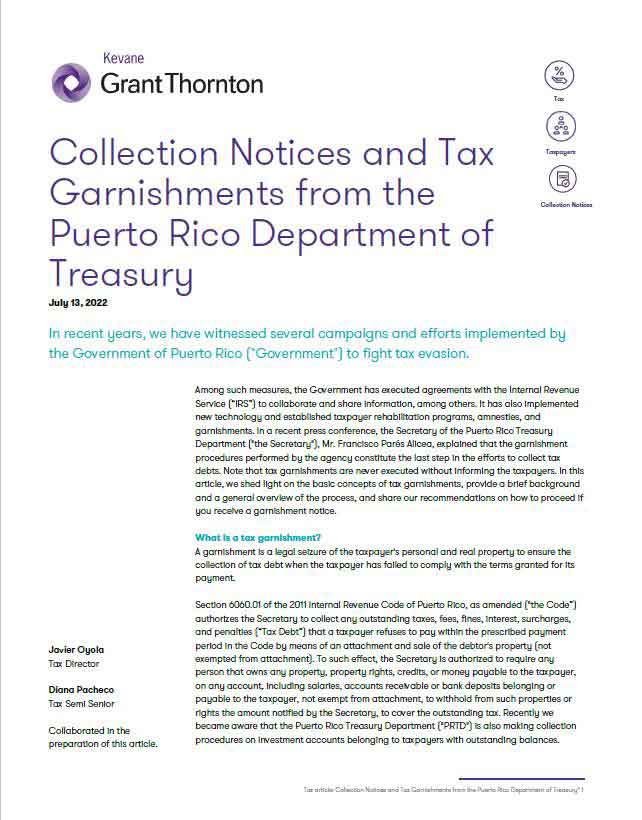-
Financial statements audits
Financial statement audits
-
Compliance audits
Compliance audits
-
Compilations and reviews
Compilations and audit
-
Agreed-upon procedures
Agreed-upon procedures
-
Corporate and business tax
Our trusted teams can prepare corporate tax files and ruling requests, support you with deferrals, accounting procedures and legitimate tax benefits.
-
International tax
Our teams have in-depth knowledge of the relationship between domestic and international tax laws.
-
Tax compliance
Business Tax
-
Individual taxes
Individual taxes
-
Estate and succession planning
Estate and succession planning
-
Global mobility services
Through our global organisation of member firms, we support both companies and individuals, providing insightful solutions to minimise the tax burden for both parties.
-
Sales and use tax and indirect taxes
SUT/ VAT & indirect taxes
-
Tax incentives program
Tax incentives program
-
Transfer Pricing Study
The laws surrounding transfer pricing are becoming ever more complex, as tax affairs of multinational companies are facing scrutiny from media, regulators and the public
-
Business consulting
Our business consulting services can help you improve your operational performance and productivity, adding value throughout your growth life cycle.
-
Forensic and investigative services
At Grant Thornton, we have a wealth of knowledge in forensic services and can support you with issues such as dispute resolution, fraud and insurance claims.
-
Fraud and investigations
The commercial landscape is changing fast. An ever more regulated environment means organizations today must adopt stringent governance and compliance processes. As business has become global, organizations need to adapt to deal with multi-jurisdictional investigations, litigation, and dispute resolution, address the threat of cyber-attack and at the same time protect the organization’s value.
-
Dispute resolutions
Our independent experts are experienced in advising on civil and criminal matters involving contract breaches, partnership disputes, auditor negligence, shareholder disputes and company valuations, disputes for corporates, the public sector and individuals. We act in all forms of dispute resolution, including litigation, arbitration, and mediation.
-
Business risk services
We can help you identify, understand and manage potential risks to safeguard your business and comply with regulatory requirements.
-
Internal audit
We work with our clients to assess their corporate level risk, identify areas of greatest risk and develop appropriate work plans and audit programs to mitigate these risks.
-
Service organization reports
As a service organization, you know how important it is to produce a report for your customers and their auditors that instills confidence and enhances their trust in your services. Grant Thornton Advisory professionals can help you determine which report(s) will satisfy your customers’ needs and provide relevant information to your customers and customers’ auditors that will be a business benefit to you.
-
Transaction advisory services
Transactions are significant events in the life of a business – a successful deal that can have a lasting impact on the future shape of the organizations involved. Because the stakes are high for both buyers and sellers, experience, determination and pragmatism are required to bring deals safely through to conclusion.
-
Mergers and acquisitions
Globalization and company growth ambitions are driving an increase in M&A activity worldwide as businesses look to establish a footprint in countries beyond their own. Even within their own regions, many businesses feel the pressure to acquire in order to establish a strategic presence in new markets, such as those being created by rapid technological innovation.
-
Valuations
We can support you throughout the transaction process – helping achieve the best possible outcome at the point of the transaction and in the longer term.
-
Recovery and reorganization
We provide a wide range of services to recovery and reorganisation professionals, companies and their stakeholders.
Among such measures, the Government has executed agreements with the Internal Revenue Service (“IRS”) to collaborate and share information, among others. It has also implemented new technology and established taxpayer rehabilitation programs, amnesties, and garnishments. In a recent press conference, the Secretary of the Puerto Rico Treasury Department ("the Secretary"), Mr. Francisco Parés Alicea, explained that the garnishment procedures performed by the agency constitute the last step in the efforts to collect tax debts. Note that tax garnishments are never executed without informing the taxpayers. In this article, we shed light on the basic concepts of tax garnishments, provide a brief background and a general overview of the process, and share our recommendations on how to proceed if you receive a garnishment notice.
What is a tax garnishment?
A garnishment is a legal seizure of the taxpayer's personal and real property to ensure the collection of tax debt when the taxpayer has failed to comply with the terms granted for its payment.
Section 6060.01 of the 2011 Internal Revenue Code of Puerto Rico, as amended ("the Code”) authorizes the Secretary to collect any outstanding taxes, fees, fines, interest, surcharges, and penalties (“Tax Debt”) that a taxpayer refuses to pay within the prescribed payment period in the Code by means of an attachment and sale of the debtor's property (not exempted from attachment). To such effect, the Secretary is authorized to require any person that owns any property, property rights, credits, or money payable to the taxpayer, on any account, including salaries, accounts receivable or bank deposits belonging or payable to the taxpayer, not exempt from attachment, to withhold from such properties or rights the amount notified by the Secretary, to cover the outstanding tax. Recently we became aware that the Puerto Rico Treasury Department ("PRTD") is also making collection procedures on investment accounts belonging to taxpayers with outstanding balances.
When did this initiative start?
Tax garnishment procedures have always been part of the collection efforts provisions of Puerto Rico tax laws. Chapter 6 of Subtitle F of the Code contains dispositions regarding the process for the garnishment and sale of goods from delinquent taxpayers.
According to Puerto Rico Circular Letter 12-11, on July 19, 2012, the PRTD began a pilot program to implement the "Mechanization Program of Attachments in Depositary" ("Program"). Such Program was extended until December 6, 2012, after which the PRTD evaluated the results obtained to get the Program to work in an automated manner. The purpose of this Circular Letter was to establish the necessary and initial steps to implement the Program. The objective of such Program was to facilitate the handling of information and to generate the most efficient banking procedures regarding the filing of garnishments through the transmission of electronic files. With this goal, the Program had these four main purposes: (i) to speed up the delivery and frequency of garnishments, (ii) to optimize existing resources, (iii) to reduce the handling of attachments by paper, and (iv) reduce the manual searching processes to determine if there exists a banking relationship with the taxpayer.
The enforcement of the Program is no stranger to the public eye. One of the most notable garnishments was performed in 2016 by the former Secretary, Mr. Juan C. Zaragoza Gómez (2014-2016) as part of a strong tax garnishment campaign to El Ziperle restaurant, an iconic restaurant in the Hato Rey metropolitan area that was forced to close after this incident. The garnishment was due to the outstanding balances of Puerto Rico Sales and Use Tax.
Garnishment Process
With the implementation of the Unified System of Internal Revenue ("SURI"), the PRTD has an updated tool that facilitates the identification of delinquent taxpayers and communication exchanges with the taxpayers.
The Secretary, Mr. Francisco Parés Alicea, recently reported that the tax lien procedures performed by the PRTD are eighty-six percent (86%) correct. According to their historical information, around nine (9) out of ten (10) cases proceed. Currently, the PRTD performs the identification of delinquent taxpayers with the aid of the SURI system. It communicates with taxpayers and starts the automatic collection process through a garnishment for all debts that have been notified to the taxpayer, once the prescribed appeal period for the taxpayer has expired. Following, we provide an overview of the garnishment process conducted by the PRTD:
- every garnishment process begins with a notification sent to the debtor by certified mail, return receipt requested, and/or through the SURI Platform.
- from the date of that notification, the debtor has thirty (30) days to pay the tax debt before the PRTD or clarify the situation.
- after thirty (30) days, the PRTD has the authority to proceed with the seizure of real or personal property.
- once the garnishment has been executed, the financial institutions are required to remit the total amount seized to the Secretary.
- for any balance not covered by the initial procedure, the Secretary may resort to any other action in order to collect the debt without the need for additional notifications.
Section 6060.02(j) of the Code mentions that the Secretary may collect, in addition to the Tax Debt, the costs incurred in the custody and deposit of the seized property, together with a 10% fee of the principal of the tax owed, without surcharges when the seizure of property or the notification to the debtor, their relatives, or dependents is performed in conformance to the Code. Such amount will be payable to either the person who made the notification or the General Fund if the notice has been made by the Secretary or another employee of the Government.
What can you do if you receive a Garnishment Notice?
Any outstanding tax related to a seizure notice issued by the PRTD can be paid through the SURI Platform. If the taxpayer has evidence of the payment made or understands that the debt is not applicable, must immediately call the Automated Call Center at 787-721-2020 or present such documentation to a representative of the nearest Bureau of Collections of the PRTD. The key is to be proactive on notices issued by the PRTD. The agency has various alternatives for taxpayers, such as payment plans and offer and commitment of payment options. In cases where the taxpayer becomes aware that there are outstanding filings that will result in tax liabilities, the Treasury also offers the option of a Voluntary Disclosure Agreement. This option is for amounts that have not been assessed yet by the Puerto Rico Treasury and provides the opportunity to the taxpayer to file the outstanding returns with even a possible reduction to the additions to the tax.
For your reference, we included the following link, which contains the phone numbers of the Collections Bureaus in the different districts: Link to Collections Bureaus list.
Javier Oyola
Tax Director
Diana Pacheco
Tax Semi Senior
Collaborated in the preparation of this article.
We are committed to keeping you up to date with all tax-related developments. Please contact our Tax Department should additional information be required regarding this or any other tax issue. We will be glad to assist you.



